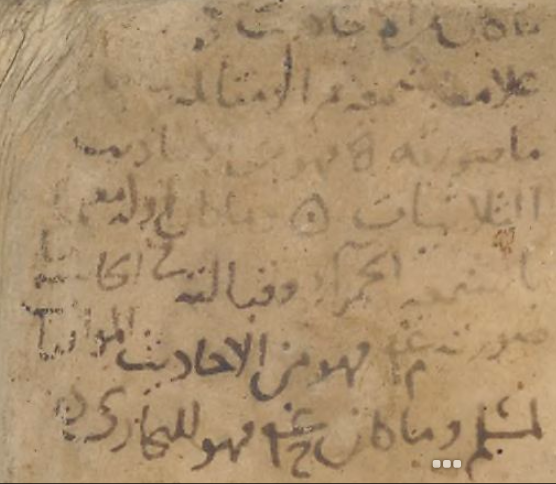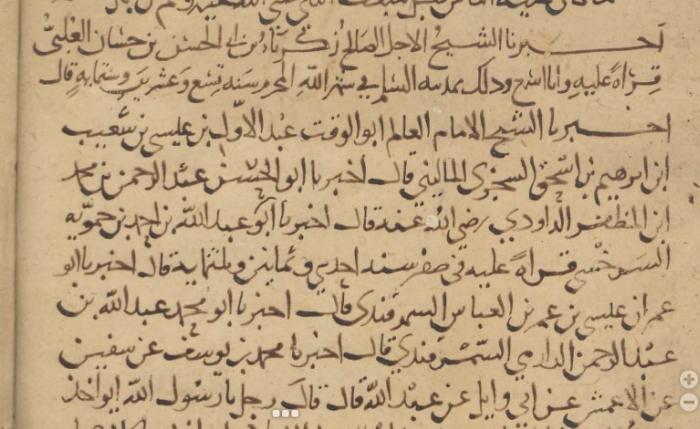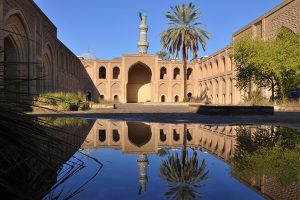About this manuscript
Al-Musnad al-jāmiʿ is a collection of sayings of the prophet Muḥammad. Though not as frequently cited as the more famous collectors such as al-Bukhārī and Muslim, al-Dārimī’s collection of some 3,500 hadiths is considered a highly authentic and respected text. The main text of this present manuscript was written in a professional book-hand which stays even from the first to the last folio. It was produced in late Abbasid-era Baghdad, where the text was transmitted in Ḥanbalī circles. (see also Brockelmann, Geschichte der Arabischen Literatur I, 164). We find information about the transmission on the first and last folios:
On f 1r
Riwāyāt
The importance of the transmission history which orally reproduced the book from al-Dārimī to the date of the present manuscript is evidenced in the way the book's title is written on the manuscript. The title page is composed of a list of riwāyāt ('narrations'/'transmissions') which record the formal steps of the text's transmission through oral sessions, from one scholar of hadith to the next. Under the title is the sub-title: Riwāyat Abī ʿImrān ʿĪsa b. ʿUmar: 'The narration of Abū ʿImrān', i.e. the 'oral edition' which Abū ʿImrān narrated of al-Dārimī's collection from al-Dārimī himself. After Abū ʿImrān, a sequence of five more expert transmitters
authenticated editions of the whole work prior to the copy we have
here.


Intriguingly, the name of the second-generation transmission, that of Abū Muḥammad ʿAbd Allāh ibn Aḥmad Ḥammuwayh was written incorrectly: the elements of his name 'ʿAbd Allāh' and 'Muḥammad' are interposed, but it seems that the copyist himself noted the error as the words مؤخر and مقدم are written above the interposed names in what seems the same pen. These words alert the reader to reverse the names (this scribal error and correction is known as al-taqdīm wa-l-taʾkhīr see Lesson 14).
Overall, the lay-out of the transmissions on the title page shows the importance attached to mentioning these editions. Note that the name of the author, al-Dārimī, in the second line of the title is written in the same sized letters as the names of each of his collection's subsequent narrators. As in famous handbooks today, the edition is effectively part of the title.
In practice, different oral editions of some Arabic books have considerable variations, hence specialist scholars would need to know the narration. These chains of transmission for the book as a whole function like isnads for individual hadith (see also Lesson 22).

Hadith scholarship annotation
In the upper left corner, there is a code-key explaining the marks written on the manuscript to identify different kinds of hadith in al-Dārimī's collection. Those which are also narrated in the famous collections of al-Bukhārī or Muslim are noted in the margin, as are 'Three-narrator-chain' hadith (thulāthiyyāt), i.e. hadith which al-Bukhārī collected from a sequence of old shaykhs, only three generations removed from the Prophet himself. The rest of the note is difficult to read: a partial rendering is:


ما كان من الأحاديث ... علامة ...؛ ما صورته ه فهو من الأحاديث الثلاثيات؛ وما كان أوله معـ... الحمراء وقابلته في الحاشية؛ ما صورته غم م فهو من الأحاديث الموافقات لمسلم؛ وما كان غم ح فهو للبخاري
Ownership (tamalluk) notes and stamps
Successive owners of this manuscript also inscribed their names and brief notes on the title page.
Top right: … Muḥammad ibn Maḥmūd al-Murāghī al-Safāʾī.
To the left of this ownership note something has been erased, possibly the name of a former owner.
Centre of the page, below the title:
“God delivered this book of hadiths into the hands of his most humble worshiper, Muṣtafā ibn ʿAbd Allāh ibn Iyās (?) ibn Muḥammad, may the Master, the One forgive them all. The date: 959 AH”
هذا الكتاب من الأحاديث ساقه الله إلى يد أضعف عباده مصطفى بن عبد الله بن إياس بن محمد عفا عنهم الملك الأحد بتاريخ سنة ٩٥٩


Centre of the page, right margin: “Now the turn of ʿAbd (al-ʿIzz?) ibn Abī Jamāl al-Ḥanafī”
في نوبة عبد ... بن أبي جمال الحنفي
Above this tamalluk is another of ʿAbd Allāh ibn Abī (al-Mukarram?) al-Maqdisī
عبد الله بن أبي المكـ ... المقدسي عفا الله عنــ
There is also one ownership stamp or signet ring impression and a wax seal.
What appears to be a hadith is also inscribed on the title page: it is partially effaced, and it does not appear al-Dārimī's collection: it describes 'the best of all people' as those with 'soaring resolution', but its full message and source remain unclear.
أن خير الناس طرا من ... رجل همته تسمو إلى
F 1v
Following the title page, the next folium begins the text of al-Musnad, and true to the format of the importance of oral recitation, the incipit is yet another lengthy preamble describing the passage of the text (both orally and in writing) from the present narration down to Abu ʿImrān's transmission of the book from al-Dārimī. The text essentially repeats the names of the transmissions listed on the title page with some additional information:
أخبرنا الشيخ الصالح زكرياء بن أبي الحسن بن حسان العلبي قراءة عليه وأنا أسمع وذلك بمدينة السلام في شهر الله المحرم سنة تسع وعشرين وستمائة قال: أخبرنا الشيخ الإمام العالم أبو الوقت عبد الأول بن عيسى بن شعيب بن إبراهيم بن إسحاق السجزي الماليني قال ...أخبرنا أحمد بن حمويه السرخسي قراءة عليه في صفر سنة إحدى وثمانين وثلاثمائة قال أخبرنا أبو عمران عيسى بن عمر بن العباس السمرقندي قال...

Note the first mentioned narration in this passage is that of Zakariyyā al-ʿUlbī: the fifth narrator in the sequence of the book’s transmission as noted on the cover. We read that he convened a session where his transmission of al-Dārimī’s al-Musnad was read in his presence (qirāʾatan) in “Madīnat al-Salām” (Baghdad) in Muḥarram 629 (November 1231). This reading was performed aloud before an assembly, as the narrator of this version of al-Musnad mentions here that “I was listening” (wa anā asmaʾ) when Zakariyyā orally 'published' and authorised his transmission.
The preamble continues, mentioning each of the earlier steps of transmission, including a note that Abū ʿImrān's version was transmitted by Aḥmad ibn Ḥammuwayh al-Sarakhsī, in a reading session during the month of Ṣafar 381 (April/May 991), and then it continues to al-Dārimī, and the hadiths narrated by him (with their isnads) finally commence.
Together, the title page and first page of the text combine to demonstrate to the reader of this manuscript that its contents were transmitted through authoritative channels from al-Dārimī in the mid-third/ninth century to the manuscript's writing in the middle of the seventh/thirteenth century.

On f 283v: colophon
The colophon on f 283v states that the copyist, ʿAbd Allāh b. Muḥammad b. Yūsuf b. Saʿīd b. Masāna b. Jamīl al-Muqriʾ al-Baghdādī, completed the copying in the month Shaʿbān 634 (April 1237), in the Mustanṣiriyya Madrasa (a famous school in Baghdad then and now).
The date of this manuscript's production is thus five years later than the date on the incipit page (f 1v): this is because the incipit inscription refers to the date when Zakariyyā authorised his transmission in 629/1231; the present manuscript represents the text as copied by one of the audience members on that day. The name of that audience member is preserved on the title page of the manuscript: the last line of the title block refers to the transmission of ʿAbd Allāh ibn Aḥmad ibn Abī al-Makārim, and he was the figure who on the incipit page refers to having ‘heard’ Zakariyyā recite the text.
Double-checking the manuscript
Also in accordance with the usual principles of careful textual transmission, this manuscript was checked against other manuscripts of al-Dārimī’s al-Musnad: details of these checkings were provided and corrections were noted in the margins. The way in which scholars of hadith recorded the precise processes and history of oral recitation were an integral part of their manuscript culture, and involve even more detail than the transmission sequences considered in this lesson. The next lessons 'The Oral Book' and 'Collation' will look at the reading of manuscripts in further detail.
More about this manuscript: Lessons Quires and quire signatures, The Oral Book, and Collation.
Further reading
S. Aljoumani, صور الاجازات المنقولة في مخطوطات العربية , السبب والوظيفة Journal of Islamic Manuscripts 9 (2018), 100-72.
S. Leder, ‘Spoken Word and Written Text. Meaning and social significance of the institution of riwāya’ in Islamic Area Studies Working Paper Series 31, Tokyo 2002.
P. Pavlovitch, “Ḥadīth”, in: Encyclopaedia of Islam, THREE, Edited by: Kate Fleet, Gudrun Krämer, Denis Matringe, John Nawas, Everett Rowson. Consulted online on 13 August 2020.
G. Schoeler, The Oral and the Written in Early Islam, 2006.
Questions
-
Compare the list of transmissions on the Title page (f 1r) with the list in the first paragraph of the incipit page (f 1v). Match each step of the transmission, and identify the fuller names of the narrators given on the incipit page. You will see that the order in which the narrators are listed is reversed, and the name of the sixth narrator is not included: why is this?
Assignments
-
The dates of birth and death of three of the transmitters named on f1v are known: Abū al-Waqt al-Sijzī lived 458-553 AH, al-Dāwudī 374-467 AH, al-Sarakhsī 293-381 AH. Consider these dates and the age of these people when their paths crossed. According to the transmission history, they represent direct links on the chain of transmission. Was such a situation exceptional in the transmission of Arabic books? Consult the literature mentioned (notably Hirschler and Pavlovitsch) and write a paper. Submit through Brightspace.
